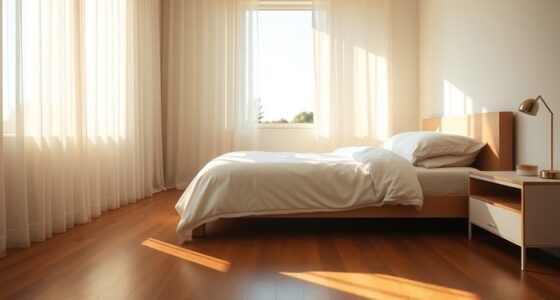To boost morning alertness, you should get exposed to natural sunlight within the first 30 minutes of waking. If outdoor light isn’t available, use a light therapy device that mimics natural sunlight to reset your internal clock. Dim artificial lights in the evening to promote better sleep. Maintaining consistent exposure helps regulate your circadian rhythm and improves energy. Keep going to discover more practical tips and tools for optimizing your light-based biohacking.
Key Takeaways
- Prioritize morning sunlight exposure for 20–30 minutes to naturally suppress melatonin and boost alertness.
- Use light therapy devices with full-spectrum, bright light to simulate natural morning sunlight indoors.
- Adjust window coverings to maximize early daylight entry into your environment for optimal circadian regulation.
- Incorporate wearable light therapy glasses or bracelets to ensure consistent light exposure if outdoors isn’t feasible.
- Minimize evening artificial light, especially blue light, to prevent circadian disruption and support morning alertness.
Understanding Your Body’s Internal Clock and Light Cycles
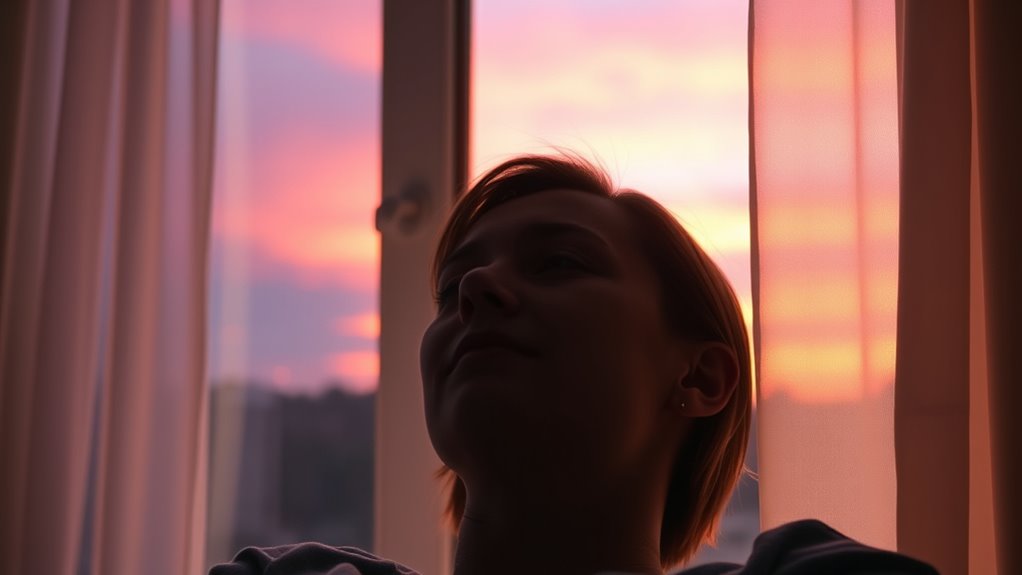
Your body’s internal clock, known as the circadian rhythm, governs your sleep-wake cycle and influences many physiological processes. Light exposure plays a vital role in circadian entrainment, helping your body stay synchronized with the day-night cycle. When you encounter light, especially in the morning, it triggers melatonin suppression, making you feel alert and awake. Additionally, light therapy has been shown to be an effective method for adjusting circadian rhythms, particularly in cases of jet lag or shift work. Conversely, darkness signals your body to produce melatonin, promoting sleep. Understanding how light affects your internal clock allows you to optimize exposure for better morning wakefulness and restful nights. By strategically managing light, you can reinforce your natural rhythms, supporting overall health and energy levels. This knowledge empowers you to harness light as a tool for biohacking your sleep and wakefulness effectively. circadian entrainment is essential for maintaining consistent sleep patterns and overall well-being. Additionally, individual differences in light sensitivity can influence how effectively your internal clock adjusts to external cues. Recognizing the impact of AI-driven discoveries in healthcare, such as light-based therapies, can further enhance personalized approaches to biohacking your rhythm.
The Role of Natural Sunlight in Morning Wakefulness

Getting natural sunlight in the morning can boost your alertness and help you wake up more easily. Exposure to sunlight also lifts your mood, making the start of your day more positive. Understanding these benefits can help you optimize your morning routine for better energy and well-being. Additionally, incorporating light exposure techniques can further enhance your circadian rhythm and improve overall sleep quality. Properly timed exposure to natural light can also assist in size restrictions for tiny houses and support your body’s natural rhythms, leading to a more refreshed start to each day. Embracing Victorian-inspired design elements in your environment can create a calming space that supports your natural biological rhythms. Being aware of zodiac sign compatibility and other personality insights can help tailor your environment and routines to better suit your individual needs.
Morning Light Benefits
Natural sunlight in the morning plays a crucial role in jump-starting your wakefulness and setting a healthy circadian rhythm. Exposure to natural light helps suppress melatonin, the hormone responsible for sleep, making it easier to wake up and feel alert throughout the day. Additionally, morning sunlight benefits your skin health by promoting vitamin D production, which supports immune function and cellular repair. Regular morning light exposure can improve your overall energy levels and help regulate your sleep-wake cycle, leading to better sleep quality at night. Incorporating educational and skill-building toys into your routine can further enhance cognitive alertness during the day. Engaging in mindfulness practices alongside morning light exposure can amplify these benefits by reducing stress and improving focus. It is also important to be mindful of light pollution, which can interfere with natural circadian cues and diminish the benefits of sunlight. By prioritizing natural sunlight, you enhance your body’s natural processes, boosting alertness and promoting a healthier lifestyle. Research also suggests that consistent light exposure can support metabolic health and aid in weight management, aligning with overall wellness goals. Remember, consistent morning exposure is key to accessing these benefits and optimizing your daily performance.
Sunlight’s Impact on Mood
Morning sunlight doesn’t just boost alertness; it also plays a pivotal role in shaping your mood. Exposure to natural light influences your photoreceptor sensitivity, helping regulate your body’s internal clock and mood hormones. Additionally, this interaction with light can be optimized through sound design techniques that enhance natural ambiance in your environment, further supporting your circadian health. However, daylight variability can impact how your mood responds to sunlight each day. Here’s how sunlight affects you:
- It enhances serotonin production, lifting your mood and reducing feelings of depression.
- Consistent morning sun stabilizes your circadian rhythm, promoting emotional balance.
- Variability in daylight can cause fluctuations in mood, making regular exposure essential.
- Engaging with natural sunlight also supports cultural celebrations, fostering a sense of community and well-being.
- Understanding the influence of light exposure can help you develop better routines for mood regulation.
- Recognizing the importance of AI bifurcation can guide you in adapting to societal and workplace changes driven by AI advancements.
How Artificial Light Affects Your Circadian Rhythm

Artificial light, especially at night, can disrupt your circadian rhythm by signaling your brain that it’s still daytime. The timing of light exposure matters; late-night blue light suppresses your melatonin production, making it harder to fall asleep. Understanding how these light signals influence your body helps you optimize your schedule for better rest and alertness. Incorporating light exposure management strategies can further enhance your natural sleep-wake cycle.
Light Timing Impact
Light timing plays a crucial role in regulating your circadian rhythm, and artificial light can disrupt this delicate balance if not managed properly. Seasonal variations affect natural light exposure, making it harder to sync your internal clock year-round. Proper timing guarantees you get enough morning light to boost alertness and avoid late-day light that can delay sleep. Consider these points:
- Morning light exposure helps reset your circadian rhythm, especially when days are shorter in winter.
- Avoid bright lights late in the evening to prevent delaying melatonin production.
- Adjust light intensity based on season—brighter mornings in winter, dimmer evenings in summer—to optimize your internal clock.
- Ensuring adequate nutrient intake supports overall circadian health and improves the effectiveness of light exposure.
- Monitoring light exposure patterns can help you make informed adjustments for better sleep and alertness. Additionally, incorporating light control devices can enhance your ability to manage light timing effectively, especially when considering the safety of electrical devices used for light management.
Managing light timing helps you stay alert and maintain better sleep, regardless of seasonal changes.
Blue Light Effects
Have you ever wondered how blue light from screens impacts your sleep? Blue light, especially at night, can cause circadian disruption by signaling your brain that it’s daytime. This suppresses melatonin, making it harder to fall asleep and reducing sleep quality. To visualize this, consider the table below:
| Light Type | Timing | Effect |
|---|---|---|
| Blue Light | Night | Disrupts circadian rhythm |
| Warm Light | Evening | Less disruptive |
| Natural Morning Light | Morning | Reinforces alertness |
Additionally, practicing mindfulness techniques can help mitigate some of the negative effects of artificial light exposure by promoting relaxation and better sleep hygiene. Recognizing the importance of light exposure in regulating your biological clock can further enhance your understanding of how to optimize alertness and rest. Incorporating encryption solutions into your digital routines can also protect your personal data while managing information about your sleep patterns. It is also important to note that zoning laws influence where tiny houses can be legally placed, which can impact your options for sustainable living environments.
Practical Strategies for Optimizing Morning Light Exposure
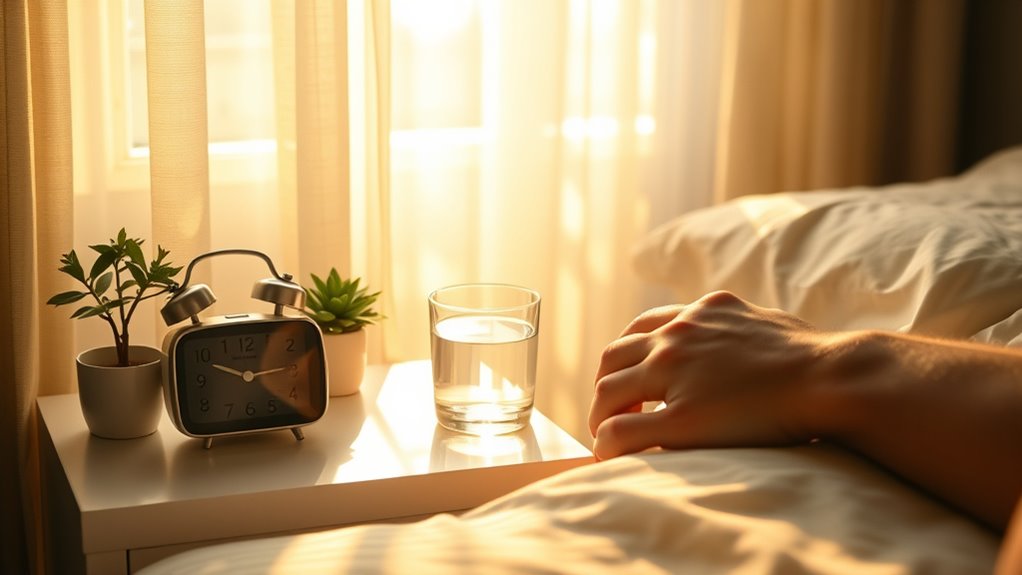
To make the most of your morning, prioritize getting natural light within the first hour after waking up. This helps with circadian synchronization, boosting alertness and mood. Here are three practical strategies:
- Spend 20–30 minutes outside in sunlight, especially on clear mornings.
- If outdoor exposure isn’t possible, use light therapy devices designed to mimic natural light.
- Adjust your window coverings to let in as much light as possible early in the day.
- Be mindful of fetal development signs that can be influenced by overall health and environmental factors.
- Incorporating automation technologies in your routine can help remind you to get morning light exposure consistently, enhancing your biohacking efforts.
These steps reinforce your body’s internal clock, improving sleep quality and daytime focus. Consistent morning light exposure is a simple yet powerful way to enhance your natural wakefulness and optimize your overall biohacking routine.
Tools and Devices to Enhance Light-Based Biohacking
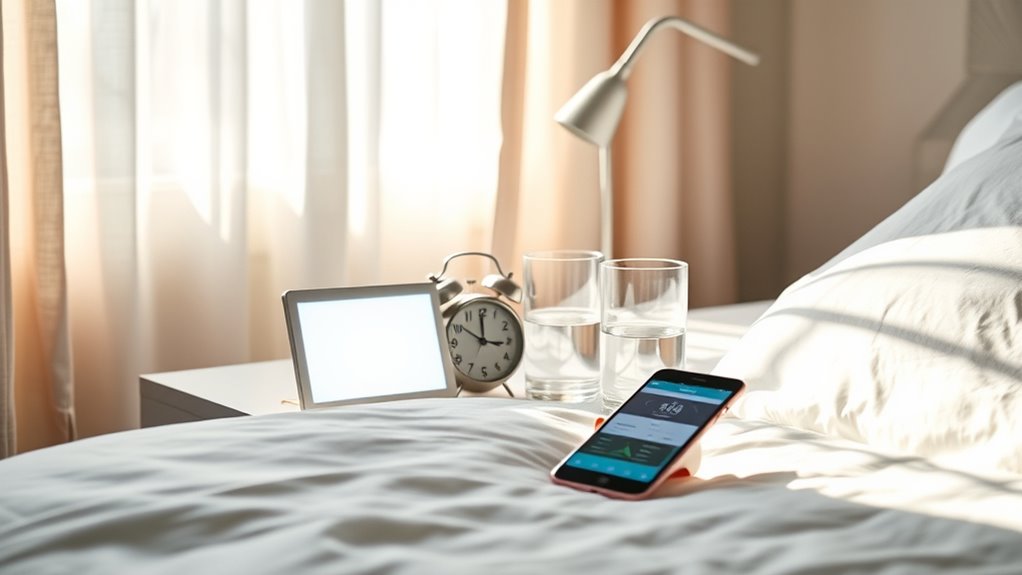
While spending time outdoors or adjusting your window coverings can boost your morning light exposure, you can further enhance your efforts with specialized tools and devices. Light therapy lamps are highly effective, emitting bright, full-spectrum light that mimics natural sunlight, helping reset your circadian rhythm and improve alertness. Wearable devices, such as light therapy glasses or light-emitting bracelets, make it easier to incorporate light exposure into your daily routine, even when indoors or on the go. These tools are designed to deliver targeted, controlled light doses, ensuring you get consistent stimulation without disrupting your schedule. Using light therapy and wearable devices allows you to optimize your morning light exposure, supporting better alertness, mood, and overall biohacking success.
Adjusting Your Environment for Consistent Alertness
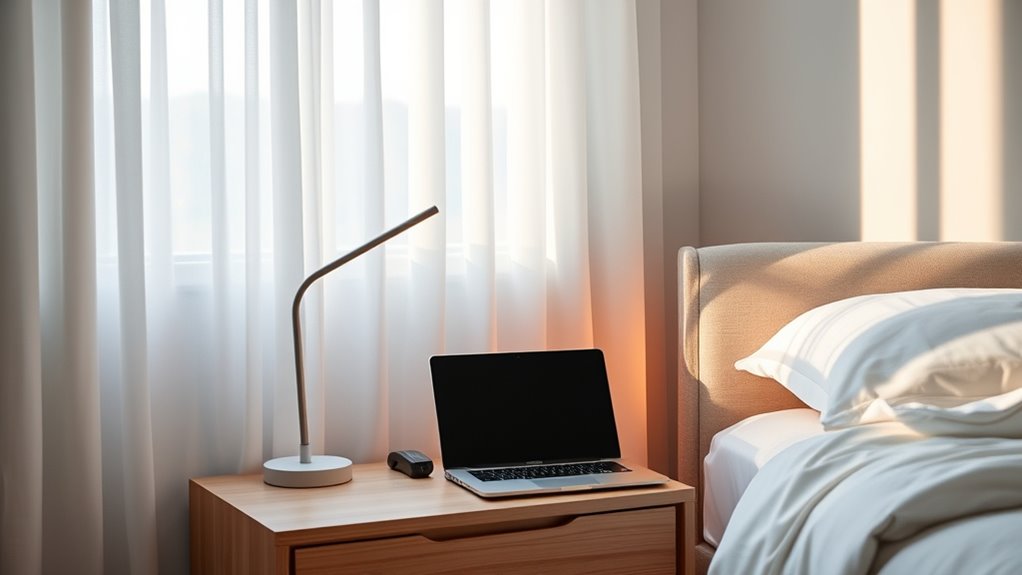
Adjusting your environment plays a crucial role in maintaining consistent alertness throughout the day. To combat circadian misalignment, you can optimize your surroundings with light therapy and strategic lighting. First, guarantee your morning exposure includes bright, natural light or a light therapy device to reset your internal clock. Second, dim or avoid harsh artificial lights in the evening to signal your body it’s time to wind down. Third, consider blackout curtains for early mornings if you’re sensitive to light, helping you sleep better and wake refreshed. These steps help synchronize your circadian rhythm, promoting alertness in the day and quality sleep at night. Proper environmental adjustments support your biohacking efforts without relying solely on supplements or devices.
Frequently Asked Questions
Can Light Exposure Improve Sleep Quality at Night?
Light exposure can indeed improve your sleep quality at night by regulating your circadian rhythms. When you get proper light during the day, it helps reset your internal clock, making it easier to fall asleep and stay asleep. Photoreceptor activation in your eyes signals your brain about the time of day, promoting better sleep patterns. So, consistent, appropriate light exposure can lead to more restful nights.
How Does Blue Light Affect My Alertness and Melatonin Levels?
Blue light markedly impacts your alertness and melatonin levels by affecting your circadian rhythms. When you’re exposed to blue light, especially in the evening, it suppresses melatonin production, making it harder to fall asleep. During the day, blue light boosts your alertness and helps regulate your circadian rhythms, keeping you awake and alert. To optimize your sleep and energy, manage your blue light exposure based on the time of day.
Are There Any Health Risks With Prolonged Artificial Light Exposure?
Prolonged artificial light exposure can pose health risks, especially if it contributes to light pollution and circadian disruption. You might experience difficulty sleeping, increased stress, or hormonal imbalances. Continuous exposure to bright or blue light at night interferes with your melatonin production, disrupting your body’s natural rhythms. To protect your health, limit artificial light exposure in the evening, use dim lighting, and avoid screens before bedtime.
What Is the Ideal Duration of Morning Light Exposure?
Did you know that just 20-30 minutes of morning light can considerably boost alertness? For best timing, aim to get this light exposure within the first hour after waking. The ideal duration of morning light exposure varies, but generally, 20-30 minutes is effective. This helps regulate your circadian rhythm, improving sleep and mood. Make sure to get this light during daylight hours for the best results.
Can Light Therapy Help With Seasonal Affective Disorder?
Light therapy can markedly help with seasonal depression by exposing you to bright light that mimics natural sunlight. It stimulates your brain’s production of mood-enhancing chemicals, reducing symptoms of seasonal depression. You should use a light therapy box daily, especially in the mornings, for about 20-30 minutes. Consistent use often leads to improved mood and energy levels, making it a practical, non-invasive treatment option for seasonal affective disorder.
Conclusion
By tuning into your body’s natural rhythms and optimizing your light exposure, you set the stage for lasting morning alertness. Remember, a little light goes a long way—like the saying, “Morning is when we set the tone for the day.” Embrace these strategies, use the right tools, and adjust your environment to make each morning brighter and more energized. Your body will thank you, and you’ll start each day on the right foot.


